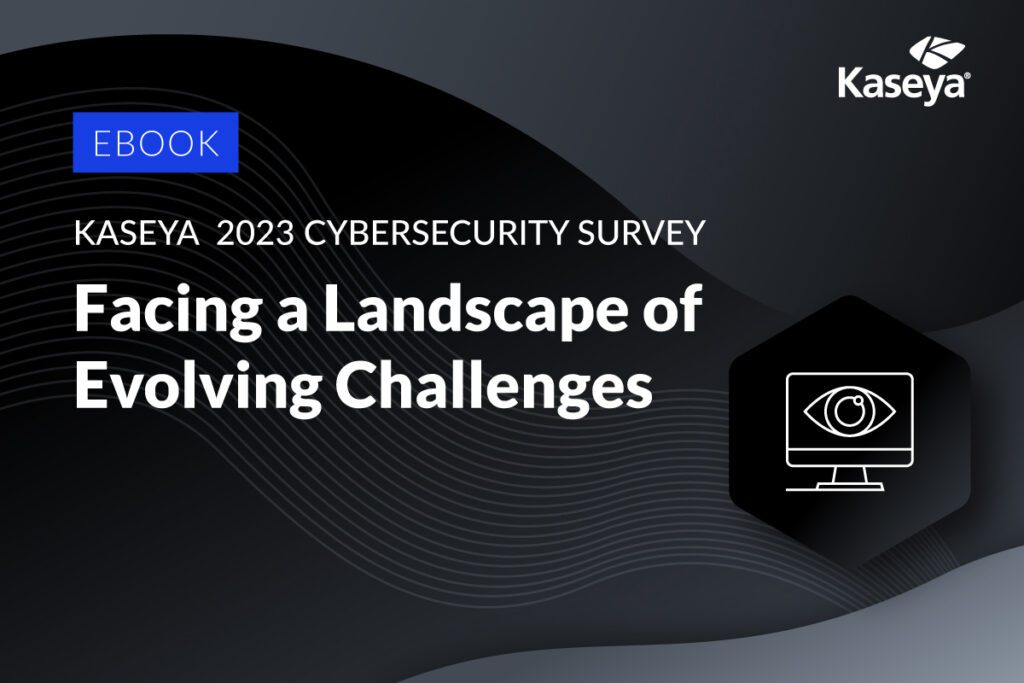Ransomware Detection: Techniques, Indicators and Why You Need It

One of the biggest cyberthreats in today’s digital-first landscape is ransomware. Cybercriminals have become relentless in their attempts to achieve their malicious goals, and ransomware has become an effective channel.
At the current rate and intensity of ransomware attacks in 2023, cybercriminals stand to accrue an estimated $900 million before January 2024. It is evident that organizations and individuals alike need to up their cyber resilience and vigilance before it’s too late.
The best possible way to do that is by implementing cybersecurity solutions and improving security policies to curb the number of ransomware vectors. A good place to start is with ransomware detection.
In this article, we’ll delve into the world of ransomware detection and touch upon critical topics that are sure to help broaden your understanding of ransomware and how to best avoid this devastating cyberthreat.

Every business faces insider risk, from employee mistakes to malicious acts. Learn how to mitigate it. DOWNLOAD EBOOK>>
What is ransomware detection?
Ransomware detection is the process of identifying and eliminating the risk of a ransomware attack before it can encrypt a system’s data, rendering it inaccessible until a ransom is paid or a specific demand is met. This crucial aspect of cybersecurity involves implementing technologies, strategies and tools to detect the presence of ransomware and mitigate its impact.
Listed below are some of the most common ransomware detection practices employed by cybersecurity professionals today.
- Signature-based detection
- Behavior-based detection
- Deception-based detection
- Detection by abnormal traffic
We’ll elaborate more on these techniques and how they help detect ransomware in an IT environment in a bit. First, let’s take a look at why it’s vital to catch ransomware in an organization’s systems as quickly as possible.
Why is early ransomware detection important?
Detecting ransomware proactively can help businesses and individuals save themselves from a world of trouble. It helps them prevent severe reputational and monetary damage. Early detection of ransomware also enables them to:
- Better protect data: Swift detection allows organizations to protect their information, like intellectual property and employee and customer data. Ransomware typically encrypts files, making them inaccessible. Identifying ransomware early provides an opportunity to halt the encryption process before any irreversible damage occurs.
- Ensure business continuity: Early detection helps maintain business continuity. By recognizing ransomware in its initial phases, organizations can isolate affected systems and prevent the ransomware from spreading across networks and disrupting essential business operations.
- Prevent financial loss: Timely detection reduces the risk of financial loss associated with ransom payments. Organizations can take preventive measures, lowering the likelihood of succumbing to ransom demands and incurring significant financial damages.
- Prevent data exfiltration: Most ransomware variants threaten to leak sensitive information unless a ransom is paid. Early detection allows organizations to prevent or limit data exfiltration, ensuring no disclosure of sensitive information and maintaining the trust of customers and stakeholders.
- Carry out quick, cost-effective remediation: Swift detection empowers organizations to initiate rapid response and remediation measures. This may involve isolating affected systems, restoring data from backups and implementing security patches to address vulnerabilities exploited by the ransomware.
- Avoid operational downtime: Ransomware attacks often lead to operational downtime. Early detection minimizes downtime by allowing organizations to take immediate action, reducing the overall impact on productivity and service delivery.
- Ensure compliance: Timely detection is crucial for compliance with data protection regulations. It helps organizations to report incidents promptly, implement necessary security measures and avoid potential legal consequences.
Early ransomware detection helps significantly reduce the risk of a ransomware attack. It protects an organization’s long-term interests as well by safeguarding data, minimizing downtime and avoiding financial and reputational hurdles.

See the challenges companies face & how they’re overcoming them in our Kaseya Security Survey Report 2023 DOWNLOAD IT>>
What are common indicators of a ransomware attack?
Each iteration of ransomware possesses unique characteristics. However, there are certain ways to identify an ongoing ransomware attack by observing specific irregularities. An unmistakable sign of a ransomware attack is an unusual surge in disk activity. It is crucial to bear in mind that ransomware systematically scans each folder for data to encrypt. Depending on the nuances of the attack, organizations or individuals, including other users on the same network, might observe a decrease in system responsiveness.
Here are a few other indicators of a ransomware attack:
- Creation of new accounts, particularly privileged accounts, to be used as backdoors
- Glitchy security or backup systems
- Increased activity in continuous data protection (CDP) systems
- Unauthorized software installations
- Unsuccessful attempts to access network shares or applications

Find out how Datto EDR helps with Health Insurance Portability and Accountability Act (HIPAA) compliance. GET INFO>>
Ransomware detection techniques
As mentioned earlier, there are various ransomware detection techniques, but we’ve highlighted some of the most common ones and elaborated on them below.
Signature-based detection
Signature-based detection is an effective technique to spot malicious activities in an organization’s IT network. It involves examining network traffic, identifying known patterns or signatures of previously identified ransomware and issuing an alert upon discovering a match.
Here’s a quick breakdown of how signature-based detection works:
- The detector generates unique identifiers for known attacks.
- It then scans the data to find attacks.
- The detector compares the network traffic to known signatures.
- It then generates an alert when a match is made.
- The file is considered a threat and automatically gets blocked.
It is important to note that while signature-based detection is effective against known threats, it may struggle against new or evolving ransomware strains that have yet to be registered.
Behavior-based detection
The behavior-based detection method involves the monitoring of user activity and comparing it to certain, predetermined criteria. Using this technique, professionals can detect suspicious or unusual behavior, like unusual login times, multiple failed attempts at logging into a privileged account and system usage.
Behavior-based detection does not depend on any updates to the signature; it detects new threats via heuristics. This implies that it can frequently identify emerging threats more quickly than signature-based detection.
Behavior-based detection can be implemented in the following ways:
- Extracting malware semantics, or behavioral traits, from a ransomware’s code.
- Studying patterns, such as frequency/periodicity of identified risk incidents, destinations or volumes exchanged, which express whether any specific behavior exceeds a specified baseline.
Behavior-based detection serves as an effective way to protect against advanced threats like ransomware, zero-day malware and fileless malware.

Find out about five of today’s biggest dark web threats to businesses in this infographic. DOWNLOAD IT>>
Deception-based detection
Deception-based detection involves setting traps or decoys within a network to deceive and lure a ransomware threat. These decoys imitate legitimate files or systems, attracting the attention of ransomware. When the ransomware interacts with these decoys, it exposes its presence, triggering alerts for security personnel.
This detection technique aims to detect ransomware in the early stages of an attack, often before it can cause significant harm. It also reduces the time a cybercriminal spends in an organization’s IT environment and offers insights into tactics, techniques and procedures (TTP) and indicators of compromise (IOC).
Detection by abnormal traffic
Also known as anomaly detection, using abnormal traffic to detect ransomware involves monitoring network activities for unusual patterns that may indicate a ransomware attack. This includes spikes in outbound traffic or communication with suspicious IP addresses.
Ransomware usually communicates with command-and-control servers for its instructions or to share encryption keys, activities that can lead to abnormal traffic patterns in an IT network. Analyzing such deviations in a network’s traffic from normal behavior is crucial for identifying ransomware early in its lifecycle.

Follow the path to see how Managed SOC heroically defends businesses from cyberattacks. GET INFOGRAPHIC>>
What are the benefits of ransomware detection?
Implementing an effective ransomware detection practice empowers businesses and individuals to better safeguard their digital assets and maintain productivity. Early detection acts as a crucial deterrent against the potential damage a ransomware attack can cause. By identifying malicious activity in its initial stages, users can swiftly initiate containment measures, preventing the widespread encryption of files and minimizing the impact on critical systems. It’s a proactive step to ensure the protection of valuable data while reducing the likelihood of falling victim to ransom demands, curbing financial losses and preserving the overall integrity of an organization’s IT infrastructure.
The benefits of ransomware detection also go beyond immediate incident response — it reaches out to long-term risk mitigation. Detecting and thwarting ransomware attacks helps organizations fortify their cybersecurity posture, fostering a resilient defense against evolving threats. It enables the implementation of targeted security measures, like routine system audits, employee training programs and the deployment of advanced detection technologies across an enterprise’s IT. In doing so, organizations can enhance their overall cyber readiness to combat ransomware threats, creating a more robust and secure digital environment for sustained business operations.
What are the challenges of ransomware detection?
Ransomware continues to be a persistent, evolving and challenging cyberthreat. Cybercriminals are continually refining their skills and strategies to make ransomware strains increasingly elusive. This demands more sophisticated cybersecurity practices and detection strategies.
Encryption, social engineering and rapid attack execution further complicate the identification process. Navigating these challenges is essential for fortifying a network’s cyberdefenses and ensuring timely responses to mitigate potential damages.
Listed below are some of the most pressing ransomware detection challenges:
- Constant mutation or evolution: Cybercriminals today are more creative and relentless. They frequently modify ransomware code to evade static signature-based detection.
- Encryption complexity: Ransomware’s use of encryption makes it challenging to distinguish malicious activity from legitimate file modifications.
- Sophistication of attacks: Ransomware today is built with advanced evasion capabilities, which, along with social engineering tactics employed by bad actors, increase detection complexity.
- Speed of attacks: Some ransomware strains encrypt files rapidly, leaving a limited window for detection and response.
- Ransomware-as-a-Service (RaaS): The proliferation of RaaS models and RaaS cybercriminal gangs has helped increase the frequency and intensity of ransomware deployment across the world, expanding the threat landscape.
Addressing these challenges requires a holistic cybersecurity approach, incorporating advanced detection technologies, ongoing education and collaborative efforts within the cybersecurity community.
What are the best practices for ransomware detection and prevention?
Let’s look at what organizations and individuals can do to best detect and prevent a ransomware attack and bolster their cybersecurity posture.
- Security awareness training: Regular security awareness training programs help employees recognize phishing attempts and suspicious activities, reducing the likelihood of falling victim to ransomware. Educated employees act as a critical line of defense against today’s ever-evolving social engineering tactics.
- Email security and anti-phishing protection: Strengthening email security and employing anti-phishing measures help block malicious emails at the gateway. Robust filters can prevent the delivery of phishing emails, a common vector for ransomware, reducing the risk of successful attacks.
- System updates and patch management: Keeping operating systems and software up to date is crucial. Regular system updates and patch management address vulnerabilities that ransomware often exploits, enhancing an organization’s overall cyber resilience.
- Data backup and recovery: Regularly backing up critical data and implementing a robust recovery plan is essential. In the event of a ransomware attack, organizations can restore their systems and data from backups, minimizing downtime and avoiding the need to pay ransoms.
- Antivirus and firewalls: Employing reliable antivirus software and robust firewalls provides an additional layer of defense. These tools can detect and block known ransomware signatures and malicious activities, bolstering overall cybersecurity defenses.
- Network segmentation: Implementing network segmentation limits the lateral movement of ransomware within a network. If one segment is compromised, it reduces the risk of the entire network being affected, aiding in the containment and prevention of widespread damage.
- User access management: Restricting user privileges ensures that individuals only have access to the resources necessary for their roles. This minimizes the impact of ransomware by limiting the scope of potential encryption and unauthorized access.
- Monitor and secure endpoints: Continuous monitoring of endpoints for unusual activities, coupled with robust security measures, enhances the chances of early ransomware detection. Endpoint security solutions can identify and mitigate threats before they escalate.
Implementing these best practices will help organizations bolster their security posture while preventing the devastating effects of a ransomware attack. From training users and securing email gateways to maintaining updated systems and implementing effective recovery strategies, a proactive approach is essential. By integrating these practices, organizations can establish a multilayered defense against ransomware, safeguarding their digital assets and ensuring swift, effective and cost-effective incident response times.
Support Ransomware Detection with Datto EDR and RocketCyber Managed SOC
Cybercriminals are only going to become more ruthless in their attempts to disrupt an organization’s operations for their malicious agendas. It is now absolutely critical to equip your network with the latest, most effective ransomware detection solutions and cybersecurity services. The best place to start? Well, with Datto EDR and RocketCyber Managed SOC, of course!
Datto EDR – Detect and respond to advanced threats, like ransomware and malware, with built-in continuous endpoint monitoring and behavioral analysis to deliver comprehensive endpoint defense (something that many cyber insurance companies require).
The solution also features Ransomware Rollback, an innovative and effective line of defense against ransomware. It reverts encrypted files to their original state after a ransomware attack, ensuring normal business operations are up and running without loss of time, money or data.
RocketCyber Managed SOC – Our managed cybersecurity detection and response solution is backed by a world-class security operations center that detects malicious and suspicious activity across three critical attack vectors: endpoint, network and cloud. It also includes ransomware detection that will automatically isolate devices when ransomware is detected and terminate processes identified by ransomware detection.
Learn more about our security products, or better yet, take the next step and book a demo today!

Our Partners typically realize ROI in 30 days or less. Contact us today to learn why 3,850 MSPs in 30+ countries choose to Partner with ID Agent!
Check out an on-demand video demo of BullPhish ID or Dark Web ID WATCH NOW>>
See Graphus in action in an on-demand video demo WATCH NOW>>
Book your demo of Dark Web ID, BullPhish ID, RocketCyber or Graphus now!